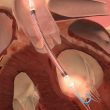Aortic valve replacement (AVR) is indicated for symptomatic aortic stenosis (AS), while close follow-up is recommended for asymptomatic patients, unless they have elevated aortic gradients, low ejection fraction, or abnormal stress tests. However, the optimal timing to perform AVR is uncertain, especially with recent evidence suggesting that patients with AS associated with signs of myocardial<a href="https://solaci.org/en/2024/02/21/short-term-outcomes-of-tavr-in-asymptomatic-or-minimally-symptomatic-patients/" title="Read more" >...</a>
Does Post-Dilation in TAVR Affect its Long-Term Outcomes?
Transcatheter aortic valve replacement (TAVR) has widely demonstrated its significant benefits, both in high-risk and inoperable patients, as well as in those with intermediate and low risk. While paravalvular regurgitation has been a challenge, its management has improved with operator experience and a deeper understanding of CT angiographies. However, in cases of regurgitation, elevated gradient,<a href="https://solaci.org/en/2024/02/01/does-post-dilation-in-tavr-affect-its-long-term-outcomes/" title="Read more" >...</a>
ACURATE Neo2: One-Year Hemodynamic and Clinical Benefit Results
Both Acurate Neo2 and its predecessor, Acurate Neo, have proven their safety and efficacy in the percutaneous treatment of severe aortic stenosis. The Acurate platform offers a lower gradient and a larger effective orifice area, as well as a low risk of periprocedural complications, according to previous registries. However, the first-generation Acurate device had some<a href="https://solaci.org/en/2024/01/12/acurate-neo2-one-year-hemodynamic-and-clinical-benefit-results/" title="Read more" >...</a>
Interventional Cardiology: The Most Read Articles of 2023
Discover the most read scientific articles on interventional cardiology of 2022 in our website. No Reflow after Primary PCI in STEMI: An Angiographic Analysis of the TOTAL Study In the early days of percutaneous coronary intervention (PCI) in patients with ST elevation acute myocardial infarction (STEMI), no reflow phenomenon was known as an indicator of<a href="https://solaci.org/en/2023/12/27/interventional-cardiology-the-most-read-articles-of-2023/" title="Read more" >...</a>
SAFE-TAVI Study: Safety and Efficacy of the Pressure Sensor and Pacing Guidewire
Currently, we observe an increase in the number of transcatheter aortic valve replacement (TAVR) procedures due to its expansion toward a younger population with lower risk. For this reason, it is crucial to maintain continuous technological innovation to minimize post-procedural complications. The FDA has approved the SavyWire, a preformed 0.035-caliber guidewire that offers three essential<a href="https://solaci.org/en/2023/12/14/safe-tavi-study-safety-and-efficacy-of-the-pressure-sensor-and-pacing-guidewire/" title="Read more" >...</a>
Predictors of Stroke at 30 Days and 6 Months After TAVR
While the rate of stroke has decreased since the early days of transcatheter aortic valve replacement (TAVR), it remains non-negligible, reaching up to 1%-3% at 30 days. As TAVR progressively expands to low-risk populations and younger patients, identifying risk factors for patient selection and management in stroke prevention becomes crucial. While researchers have identified predictors<a href="https://solaci.org/en/2023/12/11/predictors-of-stroke-at-30-days-and-6-months-after-tavr/" title="Read more" >...</a>
Is AS Only Important When Severe?
Aortic stenosis (AS) is a progressive disease associated with morbidity and mortality, especially in severe cases. However, recent studies have revealed that moderate stenosis can also have unfavorable consequences in the course of the disease. One of the challenges lies in that determining its severity is sometimes difficult due to discrepancies between valve area, gradient,<a href="https://solaci.org/en/2023/12/04/is-as-only-important-when-severe/" title="Read more" >...</a>
Is TAVR Beneficial in Cardiogenic Shock?
The presence of cardiogenic shock (CS) in a setting of aortic stenosis ranges from 1% to 4%. The prognosis for this scenario is ominous due to subendocardial ischemia, which presents as a decrease in ventricular preload and an increase in afterload. Aortic valvuloplasty has been used in this context, but, unfortunately, it has been associated<a href="https://solaci.org/en/2023/11/09/is-tavr-beneficial-in-cardiogenic-shock/" title="Read more" >...</a>
Impella in High Risk Coronary Angioplasty before TAVR
The population is aging, which is closely related with the presence of aortic stenosis. This condition, as we know, is associated with coronary artery disease (CAD) approximately in 50% of cases. In high risk surgical patients, this calls for procedures such as percutaneous coronary intervention (PCI) and transcatheter aortic valve replacement (TAVR). PCI with ventricular<a href="https://solaci.org/en/2023/11/08/impella-in-high-risk-coronary-angioplasty-before-tavr/" title="Read more" >...</a>
TCT 2023 | PARTNER 3 Low Risk: 5-Year Follwup
TCT has presented the 5-year clinical and echocardiographic outcomes of low-risk patients with severe aortic stenosis treated with transcatheter aortic valve replacement (TAVR) using balloon-expandable Sapien valves vs. surgical aortic valve replacement (SAVR). The first primary end point was a non-hierarchical composite of all-cause mortality stroke or rehospitalization. The second was a hierarchical composite including<a href="https://solaci.org/en/2023/10/30/tct-2023-partner-3-low-risk-5-year-follwup/" title="Read more" >...</a>









